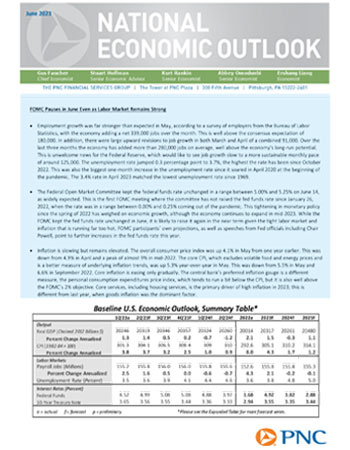The information contained in this site, is to the best of PNC Bank's knowledge, correct and accurate, but PNC Bank does not represent, warrant or guarantee its accuracy. Any downloading of material contained in this site or of any site linked to this site may be a violation of federal trademark and copyright laws.
PNC National Economic Outlook
October 2023
Economic Growth Strengthens in the Third Quarter as Consumer Spending Remains Strong
Real GDP increased 4.9% at an annualized rate in the third quarter, according to the advance estimate from the Bureau of Economic Analysis. This was up from 2.1% in the second quarter, and was the strongest quarter for economic growth since the fourth quarter of 2021. On a year-over-year basis economic growth was 2.9%, about a percentage point above the economy’s long-run potential.
The Federal Reserve remains concerned that economic growth is too strong in 2023, creating inflationary pressures in the labor market. Real consumer spending rose 4.0% at an annualized rate in the third quarter, adding 2.7 percentage points to economic growth. Inflation-adjusted goods spending was up 4.8%, while inflation-adjusted services spending was up 3.6%.
Inventories added 1.3 percentage points to third quarter growth, the biggest contribution since the fourth quarter of 2022. Real final sales of domestic product—GDP minus the change in inventories, which is a measure of demand for U.S.-produced goods and services—rose a solid 3.5% annualized in the third quarter. Household income, however, fell 1% annualized in the third quarter after adjusting for inflation.
The personal consumption expenditures price index rose 0.4% in September, matching monthly inflation in August. The core PCE price index, excluding food and energy and the Federal Reserve’s preferred inflation measure, rose 0.3% in September, up from 0.2% in August and the biggest increase since May.
On a year-over-year basis overall PCE inflation was 3.4%, the same pace as in July and August. Year-ago core PCE inflation was 3.7% in September, down from 3.8% in August and a cyclical peak of 5.6% in early 2022. Inflation is slowing, but only gradually, and it remains far above the Federal Reserve’s 2% objective. Inflation should continue to decline in the near term as the labor market softens somewhat and wage pressures abate. Slower rent growth will also contribute to a softening in housing inflation into 2024.
The UAW and the Big Three automakers reached contracts at the end of October to settle a strike that started in mid-September. Unlike in previous strikes, the UAW struck individual plants and not entire companies. Because of this the hits to employment and economic output from the strike were modest. In the October jobs report employment in motor vehicle and parts manufacturing fell by 33,000, compared to total UAW employment at the Big Three of around 145,000, and total industry employment (including parts manufacturers and foreign-brand automakers) of more than one million. With the strike settled production and employment should quickly rebound, with no significant reduction in GDP or employment.


